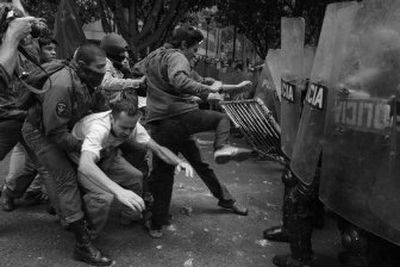Bush visits Colombia amid massive security

BOGOTA, Colombia – President Bush paid a symbolic but tightly policed visit to Bogota on Sunday aimed at shoring up conservative Colombian President Alvaro Uribe and highlighting the improved security he has brought to his violence-scarred capital city.
As Air Force One descended into Bogota, reporters aboard saw this warning displayed on the aircraft monitors: “Colombia presents the MOST SIGNIFICANT THREAT ENVIRONMENT of this five-country trip!”
On the ground, 21,000 police manned checkpoints, standing a few yards apart along the route of Bush’s motorcade to the presidential palace. Museums were shuttered, and cellular phone service was blocked in some areas. The Secret Service drove two motorcades, one a decoy, through the city to deter terrorist attacks.
The purpose of Bush’s visit was to support his firmest ally in Latin America and the recipient of more than $700 million in U.S. aid this year for Plan Colombia, a program to combat narcotic trafficking.
Bush is the first U.S. president to set foot in Bogota since Ronald Reagan visited in 1982. Political and drug-related violence had made Bogota a no-go zone for U.S. presidents for 25 years, but Uribe’s crackdown on rebel groups and a public-works campaign by city leaders have greatly decreased the threat and revived the high-altitude capital’s reputation.
Bush was lavished with full military honors when he arrived at Casa de Narino, the presidential palace.
“The most important function of a state is the ability to provide security for its people,” Bush said after an hour-long meeting and working lunch with Uribe. “I appreciate your steadfast strength. I’m looking forward to working with you on the next stage of Plan Colombia.”
Bush is unpopular in Colombia, and he was greeted by protests, as he has been during previous stops in Brazil and Uruguay. About 500 protesters chanting “Bush Out!” held a march near Bogota’s bullfighting ring, and police broke up a second protest with water cannon and tear gas. About 35 marchers were arrested.
“Plan Colombia is doing nothing but defending the interests of North America while the spraying is killing our environment, nature, water and culture,” said one protester, architecture professor Maria Gomez. “We’re here to wake people up.”
Security forces, however, were more worried about possible attacks by the leftist rebel group known by its Spanish initials FARC, still a potent force despite the $4.7 billion that the United States has spent on military, anti-terror and narcotics aid since 2000. The rebels disrupted both of Uribe’s inaugurations in 2002 and 2006 with mortar, rocket and bomb attacks.
During his joint news conference with Bush, Uribe said his country is still struggling to recover from years of political unrest.
Bush has proposed an additional $3.9 billion for Plan Colombia through 2014. Administration officials say that would average $560 million a year, a reduction from current levels.
U.S. officials expect that American support will diminish as Colombia’s economy improves and the government is able to fully finance its own security programs.